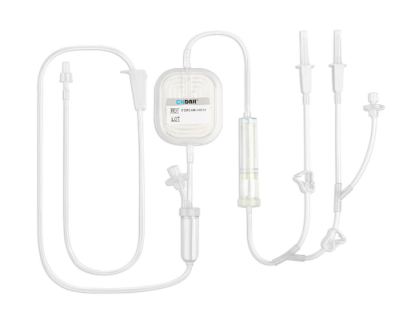In the field of modern transfusion medicine, ensuring the safety and efficacy of blood components is a top priority. One of the most significant advancements in this area is leukoreduction — the process of removing white blood cells (leukocytes) from blood products before they are transfused into patients.
While leukocytes play an essential role in the immune system, their presence in donated blood can lead to various complications for recipients. To address this, leukoreduction filters have become a critical tool in enhancing patient safety, reducing adverse reactions, and improving overall clinical outcomes.
This article explores how leukoreduction works, its clinical benefits, implementation challenges, and its growing role as a standard practice in high-quality healthcare systems around the world.
Leukoreduction refers to the selective removal of leukocytes from whole blood or specific blood components—such as red blood cells, platelets, and plasma—before they are administered to a patient. This process is typically carried out using leukoreduction filters, which are specially designed to trap white blood cells while allowing other essential components to pass through unimpeded.
Although leukocytes are vital to the body’s immune defense, they are not necessary in most transfusions and can actually cause harm when introduced into a recipient’s bloodstream. These risks include:
· Febrile non-hemolytic transfusion reactions (FNHTRs)
· HLA alloimmunization
· Transmission of leukocyte-associated viruses (e.g., CMV)
· Transfusion-related immunomodulation (TRIM)
· Reduced survival of transfused red blood cells
By filtering out these potentially harmful cells, leukoreduction significantly improves the safety profile of blood transfusions.
Leukoreduction filters are made from specialized fiber-based media that exploit differences in size, surface charge, and deformability between leukocytes and other blood components.
As blood flows through the filter, leukocytes are retained within the fibrous matrix due to their larger size and less deformable structure. Meanwhile, smaller and more flexible components like red blood cells and platelets pass through with minimal resistance.
Modern leukoreduction filters offer several key advantages:
· High efficiency: Removing over 99.9% of leukocytes
· Fast processing time: Typically completed within 5–15 minutes
· Low hemolysis risk: Designed to minimize mechanical stress on red blood cells
· Closed-system compatibility: Reduces the risk of bacterial contamination during processing
There are two main approaches to leukoreduction:
1. Pre-storage leukoreduction: Performed at blood collection centers shortly after donation.
2. Bedside leukoreduction: Conducted immediately before transfusion in clinical settings.
Of the two, pre-storage leukoreduction is generally preferred because it prevents the release of inflammatory cytokines from stored leukocytes, thereby preserving the quality of blood components and extending their shelf life.

FNHTRs are among the most common adverse events associated with blood transfusions, affecting up to 3% of all recipients. They are primarily caused by cytokines released from donor leukocytes or by the recipient's immune response to donor white cells. Leukoreduction effectively eliminates the source of these reactions, particularly benefiting patients who receive frequent transfusions.
Repeated exposure to foreign leukocytes can lead to the development of antibodies against human leukocyte antigens (HLA), complicating future transfusions and organ transplants. By removing leukocytes, leukoreduction reduces the likelihood of HLA sensitization, especially in vulnerable populations such as cancer patients and those with thalassemia.
Cytomegalovirus (CMV) resides within leukocytes and poses a serious threat to immunocompromised individuals, including neonates, transplant recipients, and chemotherapy patients. Leukoreduction serves as an effective strategy for preventing CMV transmission, often considered equivalent to using CMV-seronegative blood in many clinical guidelines.
In complex procedures such as cardiac surgery and organ transplantation, where multiple transfusions are common, leukoreduced blood has been shown to reduce post-operative infections, inflammation, and hospital stays. These benefits translate into lower healthcare costs and better recovery rates.
Frequent transfusions can suppress the immune system in oncology patients. Using leukoreduced blood minimizes this effect, helping to preserve immune function, reduce infection risk, and improve tolerance to treatments like chemotherapy and radiation therapy.
The adoption of leukoreduction varies globally, influenced by regulatory policies, healthcare budgets, and clinical practices.
· Canada and most European nations mandate universal leukoreduction for all blood components.
· In the United States, although not universally required, over 70% of blood products are leukoreduced voluntarily.
· Japan and Australia implement targeted leukoreduction strategies based on patient risk profiles.
Leading health organizations—including the World Health Organization (WHO), AABB (formerly American Association of Blood Banks), and the European Directorate for the Quality of Medicines—strongly recommend leukoreduction as a best practice, particularly for high-risk patients.
Despite its clear benefits, implementing leukoreduction universally faces several obstacles:
· Cost: Adding leukoreduction increases the cost of blood processing. However, this is often offset by reduced adverse events, shorter hospitalizations, and fewer infections.
· Infrastructure Requirements: Pre-storage leukoreduction requires advanced equipment and trained personnel.
· Access in Low-Income Regions: Many developing countries lack the resources to adopt leukoreduction widely. Increased funding, education, and technology transfer are crucial to expanding access.
As demand for safe and efficient transfusions grows worldwide, manufacturers continue to innovate:
· Miniaturized filters for use in low-resource settings
· Integrated blood bag systems combining collection, filtration, and storage
· Specialized filters for platelet and plasma components
· Eco-friendly materials to support sustainability goals
Ongoing research is also exploring the use of nanomaterials and smart membranes to further enhance filtration performance and efficiency.
Leukoreduction filters have revolutionized transfusion medicine by significantly reducing the risk of immunologic and infectious complications. Their ability to improve patient outcomes, prevent disease transmission, and support safer clinical practices makes them an essential component of modern blood banking.
As healthcare systems increasingly prioritize patient safety and cost-effectiveness, leukoreduction is expected to expand globally, becoming a standard of care—not just an option.
For hospitals, blood banks, and procurement departments seeking reliable leukoreduction solutions, DaJiMed offers cutting-edge, high-performance filters that meet international standards for quality and safety.
Copyright © Guangzhou DaJi Medical Science and Technology Co., Ltd. All Rights Reserved Sitemap | Powered by 